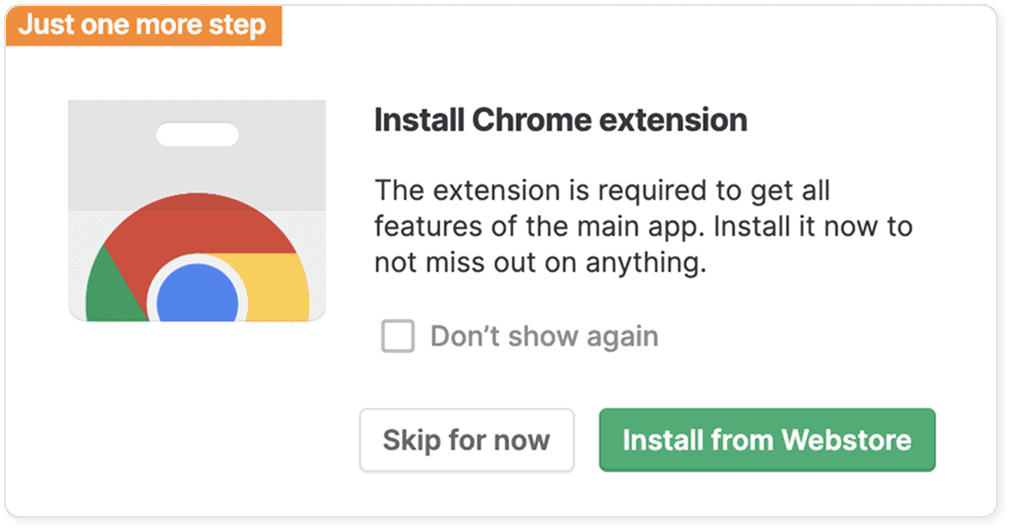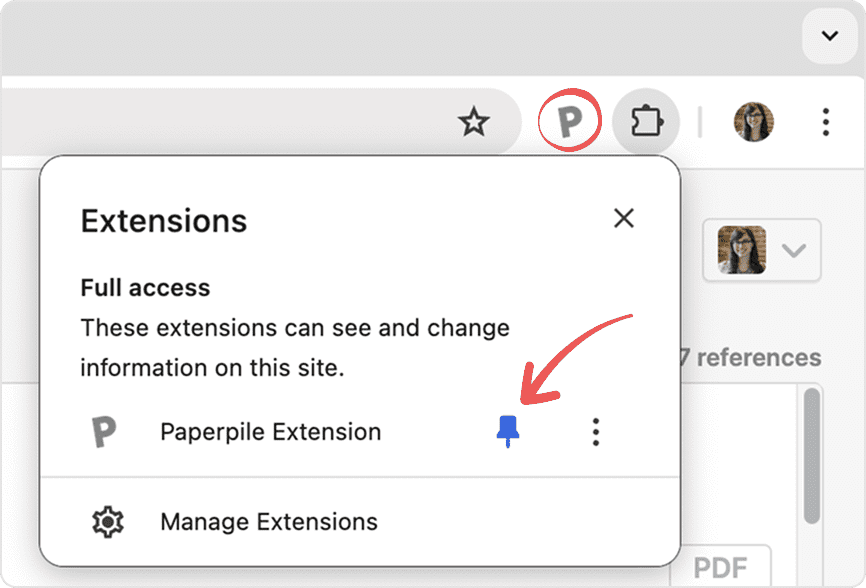Install and use the Chrome extension
The Paperpile Chrome extension lets you save references directly to your library while browsing the web. Instead of copying and pasting references or switching back to Paperpile, you can add papers from PubMed, arXiv, Google Scholar, journal websites, and thousands of other sources in one click.
Installing the Chrome extension also helps you:
- Find PDFs online. See Find and download PDFs automatically
- Create citations in Google Docs. See Get started with Paperpile and Google Docs.
- Update reference details automatically. See Update metadata automatically.
Install the Chrome extension

When you first sign up for Paperpile, you'll see an Install Chrome extension prompt in your library encouraging you to add the Chrome extension to get all the features of Paperpile.
Click Install from Webstore to go directly to the Chrome Web Store page and complete the installation.
From the Chrome Web Store
- Go to the Chrome Web Store.
- Click Add to Chrome.
- In the confirmation dialog, click Add extension.
How to use the Chrome extension

After installation, pin the Paperpile button to your browser's toolbar to keep it always visible. This lets you see the page status and save references with one click.
To pin the extension, click the puzzle piece in your Chrome toolbar, then click the pin next to Paperpile.
You'll see Paperpile in a few key places:
- The Paperpile ('P') button: The Paperpile button in your toolbar shows the status of the current page and opens the browser popup. Click the Paperpile button on any publisher webpage to save the reference to your library. See Save to Paperpile with the extension popup.
- PDF saving: When viewing PDFs in your browser, the extension can detect and save both the PDF file and its metadata. See Save to Paperpile with the extension popup.
- Buttons on academic sites: The extension automatically adds Paperpile buttons next to search results on supported websites like PubMed, Google Scholar, arXiv and others. See Save from supported databases and websites with the Paperpile buttons.
- Right-click menu: Right-click on any link and select Paperpile from the context menu. See Save files to Paperpile with the browser context menu.
Update the Chrome extension
The Chrome extension updates automatically through Chrome's built-in update system. You don't need to manually check for updates or reinstall the extension. Chrome typically updates extensions in the background within a few hours of a new version being released.
If you need to force an update, go to chrome://extensions, switch on Developer mode, and click Update to force Chrome to get the latest version.

Chrome extension permissions
Necessary permissions
The Paperpile Chrome extension requires specific permissions to function properly:
- Read and change all your data on the websites you visit (http://* and https://*). One of Paperpile's core functions is to import bibliographic data and PDF files from websites (for example, PubMed or Google Scholar). That's only possible if Paperpile can read the information on websites you are visiting. No information other than the bibliographic data you want to add to your library is accessed or transmitted to our servers.
- Read your browsing history (tabs). To manage the workflow between tabs, Paperpile needs access to the URLs opened in your tabs (for example, switch between the Paperpile web app and the PDF viewer; interact with databases such as PubMed or Google Scholar). Your browsing history remains on your computer and is not transferred to our servers.
- Modify data you copy and paste (clipboardWrite). Enables you to copy and paste citations from the Paperpile web application to other applications. The information you copy and paste remains on your computer and is never transferred to our servers.
- webRequest and webRequestBlocking. Enables Paperpile to download bibliographic data and PDF files from publishers' websites.
- Storage. Enables Paperpile to save various application settings.
- unlimitedStorage. Enables Paperpile to save your library of downloaded PDFs locally for fast access. You can always clean up locally saved files in Settings.
- contextMenus. Enables Paperpile to import papers via a right-click on hyperlinks.
These permissions let the extension automatically detect citation information and save references seamlessly. Paperpile adheres to our published privacy policy, and uses only the minimum permissions required to provide a high-quality service.
Permissions for saving files from file://
To save PDFs from your computer that you open in Chrome (file:// URLs), enable file URL access:
- Go to chrome://extensions in Chrome.
- Find the Paperpile extension and click Details.
- Turn on Allow access to file URLs.
Without this permission, the extension cannot save locally stored PDF files to your library.
Uninstall the Chrome extension
To remove the Chrome extension:
- Go to chrome://extensions in Chrome.
- Find the Paperpile extension.
- Click Remove.
- Confirm by clicking Remove in the modal window.
Uninstalling the extension won't affect your Paperpile library or account—but you'll lose the ability to save references directly from webpages and find and download PDFs automatically.
Chrome extension error handling
If the Paperpile browser extension behaves strangely, this might be some temporary glitch that can be fixed easily:
- Reload the Paperpile tab.
- Restart the browser (in Chrome, you can type chrome://restart in the address bar and the browser will restart and reopen all your tabs of the current profile).
- Sign out of Paperpile and sign in again.
If the extension stops working properly, you can restart the extension:
- Go to chrome://extensions in Chrome.
- Find the Paperpile extension.
- Switch it off, then switch back on.
- Refresh any open webpage tabs.
For persistent problems, check that you're signed into the same Paperpile account in both the web app and the extension.